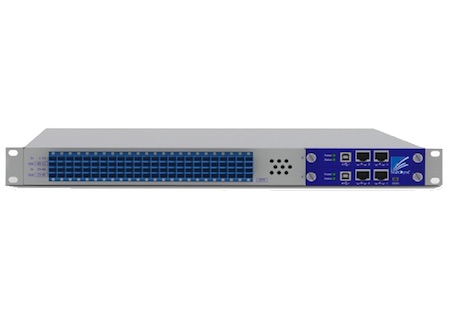
MultiDyne's New LightningSwitch Provides Simple, Cost-Effective Signal Routing
LOCUST VALLEY, NY—Sat 04, 2016—
MultiDyne, a leading provider of fiber-optic-based video and audio transport solutions for broadcast and pro A/V applications, today announced LightningSwitch, a 48x48 optical-to-optical routing switch that simplifies the routing of fiber-optic signals within broadcast infrastructures by eliminating the need for fiber patch panels. Relying on highly reliable piezoelectric beam-steering technology, LightningSwitch minimizes optical connection loss and maximizes optical performance from a high-density, compact 1-RU chassis, enabling cost-effective, trouble-free optical routing of video, audio, and data signals. Applications include broadcast and transmission facilities, sports venues, outside broadcast vehicles, cross-campus networks, postproduction, and satellite uplink management.
“Using LightningSwitch, broadcasters can route any fiber-optic signal from a control room to multiple venues or camera locations with the push of a button,” said Frank Jachetta, president, MultiDyne. “At the 2014 NAB Show, we’ll demonstrate the exceptional performance, ease of configuration, and cost-saving capabilities of LightningSwitch, which sets a new industry standard for reliability.”
LightningSwitch does not use any optical-to-electrical-to-optical conversions and is format and bit rate independent, allowing users to make the best use of fiber routing in broadcast infrastructures. Through LightningSwitch, users can route one-way and bidirectional optical signals multiplexed via TDM, CWDM, and DWDM technologies with line speeds from less than 1.5Gbs to 100Gbs and beyond. This makes it possible to unite a large combination of cameras, audio streams, video paths, and other broadcast gear onto a single optical crosspoint.
As a result, devices using up to 18 wavelengths can be multiplexed onto a single strand using MultiDyne’s FiberSaver system and then routed onto just one crosspoint via the LightningSwitch router. This makes it easy to use a single control room or OB truck and switch sources to/from various locations or studios around a campus, venue, broadcast infrastructure, or even across town.
Without additional multiplexing, traditional dual fiber-enabled studio cameras can be routed through any two LightningSwitch crosspoints, while cameras equipped with MultiDyne’s SilverBACK system need only a single LightningSwitch crosspoint.
In addition, LightningSwitch can handle any individual optical audio and video signal, whether analog or digital, including AES; SMPTE 276M, 259M, 292M, 424M; ASI/DVB; NTSC; PAL; QAM; and MADI. With LightningSwitch, there is virtually no signal latency; therefore there is no need to reclock or resync incoming signals. The LightningSwitch platform is also effective at eliminating the jitter that is typically accumulated through multiple electrical routing switches.
LightningSwitch can be integrated seamlessly with existing routing infrastructures and standard broadcast architectures. The flexible platform supports a variety of popular protocols, such as SNMP, TL1, and SCPI command languages, to enable communication with management systems. A user-friendly, Web-based interface simplifies setup, monitoring, and control. The switch software can easily be upgraded in the field without affecting in-service operations. These features enable LightningSwitch to be integrated as part of an end-to-end optical solution or within an existing infrastructure using optical-to-electrical converters.
